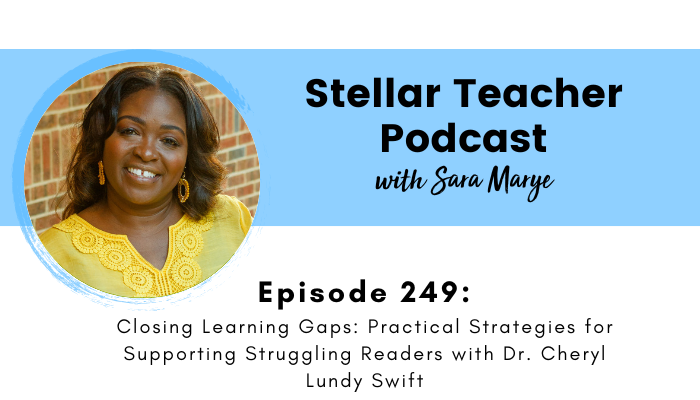
Click play below to listen to ways you can help close learning gaps for struggling readers.
Supporting students with learning gaps can feel overwhelming—but you don’t have to do it alone. In this episode, I’m joined by the amazing Dr. Cheryl Lundy Swift, host of Literacy Matters: Empowered Conversations and Director of Professional Learning and Academic Partnerships at Learning Without Tears. Cheryl brings both heart and expertise to our conversation as we talk about how to meet students where they are—especially those who are missing foundational literacy skills.
We dive into the impact of the pandemic on student learning, how to assess literacy skills in meaningful ways, and practical strategies for differentiation that benefit every student in the classroom. Cheryl shares how multisensory tools, student choice, and oral language can all be leveraged to support growth in reading and writing. Whether your students are working below, on, or above grade level, this episode is filled with actionable ideas you can start using right away.
If you’re looking for ways to help struggling readers, foster a love of literacy, or simply breathe new life into your instruction, this episode is full of encouragement and practical wisdom. Take a deep breath, grab a notebook, and let’s rethink how we can close learning gaps—one student at a time.
Meet Dr. Cheryl
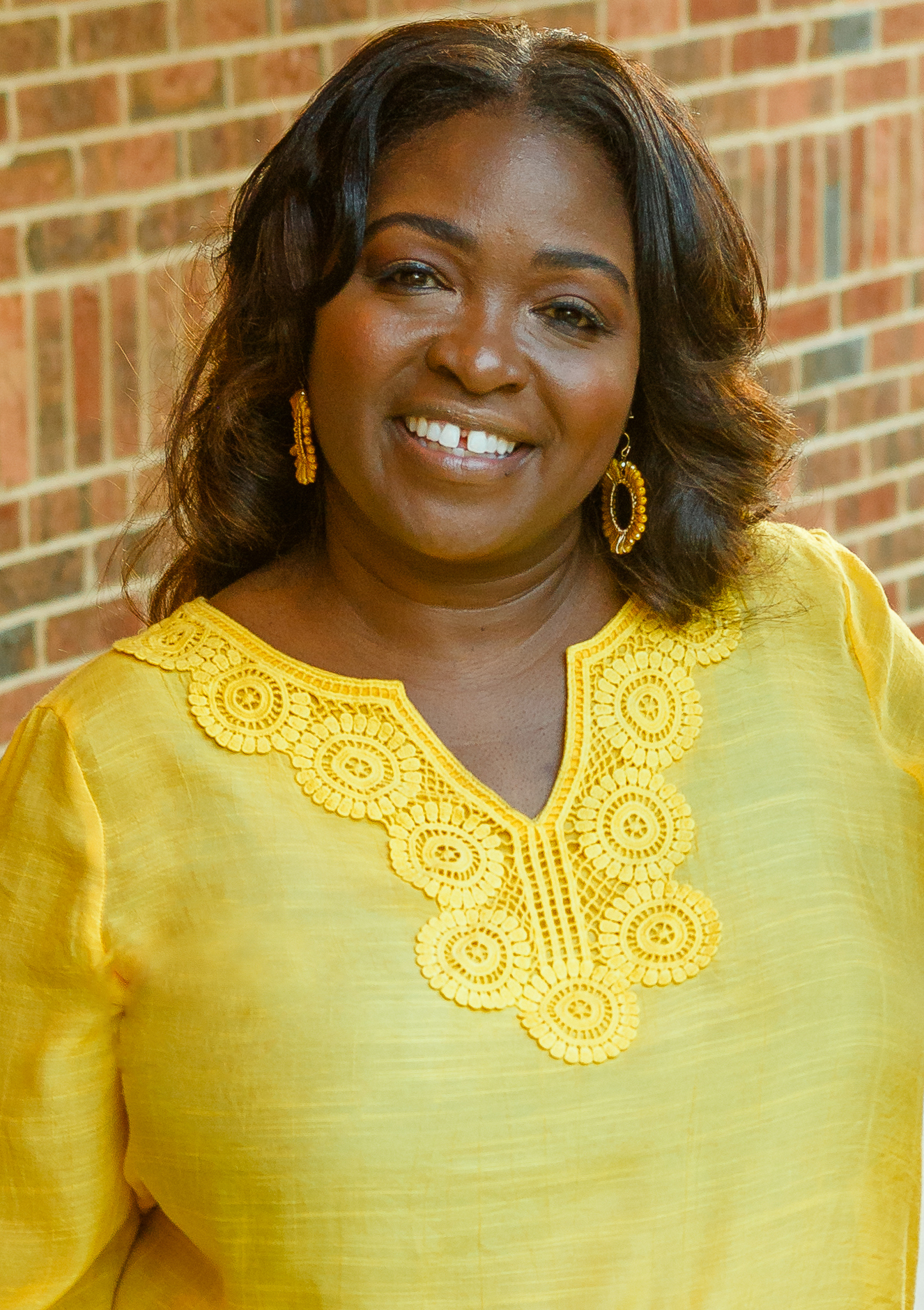
Dr. Cheryl Lundy Swift
Dr. Cheryl Lundy Swift is the host of Literacy Matters: Empowered Conversations where she interviews renown literacy researchers, authors, and practitioners to explore today’s early literacy landscape and to provide school leaders, teachers, and families practical solutions. Cheryl also serves as Learning Without Tears’ Director of Professional Learning and Academic Partnerships where she leads the curation of professional learning experiences for teachers and school leaders worldwide and partners with schools to provide practical literacy solutions. Cheryl is an award-winning educational leader, curriculum developer, motivational speaker, and facilitator; her unique mix of wit, grit, and passion ‘edutains,’ inspires, and equips school leaders, teachers, and families to help students reach their fullest potential.
In this episode on closing learning gaps for struggling readers, we share:
- Practical tips for using everyday classroom moments as formative assessments
- Why learning gaps widened after the pandemic—and how to respond with intention
- Tips for using daily classroom observations to track and address learning gaps
- The power of multisensory and multimodal instruction to boost engagement and retention
- Creative ways to build student confidence while addressing persistent learning gaps
- Why sentence-level writing instruction should be a focus in every literacy block
- Ways to bring more joy, choice, and purpose into your literacy instruction
Resources:
- Join The Stellar Literacy Collective
- Sign up for my Private Podcast: Confident Writer Systems Series
- Sign up for my FREE Revision Made Easy email series
- If you’re enjoying this podcast, please leave a review on Apple Podcasts!
Related episodes and blog posts:
- Episode 161, 5 Reasons Why You Need to Spend More Time on Sentence Writing in Upper Elementary
- Episode 132, Two Simple Ways to Boost Engagement During Whole Group Lessons
- Episode 55, Creative Ways to Assess Student Learning
- Utilizing Exit Tickets to Gauge Student Understanding
Connect with me:
- Join my newsletter
- Shop my TPT store here
- Subscribe to our YouTube channel
- Instagram: @thestellarteachercompany
- Facebook: The Stellar Teacher Company
More About Stellar Teacher Podcast:
Welcome to the Stellar Teacher Podcast! We believe teaching literacy is a skill. It takes a lot of time, practice, and effort to be good at it. This podcast will show you how to level up your literacy instruction and make a massive impact on your students, all while having a little fun!
Your host, Sara Marye, is a literacy specialist passionate about helping elementary teachers around the world pass on their love of reading to their students. She has over a decade of experience working as a classroom teacher and school administrator. Sara has made it her mission to create high-quality, no-fluff resources and lesson ideas that are both meaningful and engaging for young readers.
Each week, Sara and her guests will share their knowledge, tips, and tricks so that you can feel confident in your ability to transform your students into life-long readers.
Tune in on your favorite podcast platform: Apple, Google, Amazon, Spotify, Castbox, and more! If you’re loving this podcast, please rate, review, and follow!
Podcast (stellar-teacher-podcast): Play in new window | Download
Sara
Hey there, stellar teachers. Welcome back to another episode of the Stellar Teacher Podcast. Now, if you’ve ever felt the challenge of meeting your students where they are—especially when it comes to filling those literacy gaps—then today’s episode is for you. Today, I’m joined by the incredible Dr. Cheryl Lundy Swift, who is the host of the show Literacy Matters: Empowered Conversations and is also the Director of Professional Learning and Academic Partnerships at Learning Without Tears. Cheryl is a passionate educator, speaker, and curriculum expert who brings a powerful mix of wit, grit, and heart to her work—and you’ll get to experience a little bit of that in our conversation today.
During our interview, we dive into real, practical strategies for teaching and connecting with third through fifth grade students who may be behind in some of those fundamental literacy skills. From understanding the impact the pandemic had on learning gaps to using multisensory methods and engaging students in writing, Cheryl has so many valuable insights to share. So let’s go ahead and jump right in.
Hi, Cheryl. Welcome to the show. I am so excited that you are joining us today.
Cheryl
Oh, Sara, thank you so much for having me on.
Sara
So I know we’re going to talk today about how to really support students who have learning gaps—who are missing important information in some of those foundational areas. But before we really jump into the nitty-gritty of that, can we talk a little bit about how the pandemic has impacted either existing gaps or widened learning gaps that exist, specifically in literacy?
Cheryl
Sure. One of the things I think it’s really important to note, Sara, is that there were gaps before COVID. I don’t want people to get the idea that COVID suddenly brought about learning gaps in reading—or math, for that matter. We actually just got some scores from NAEP recently, and they’re a little lower than they were even before the pandemic. So we’ve seen a dip even from last year.
What I want people to recognize is that there’s definitely been an impact from COVID. Think about it this way: COVID affected the school year from 2019 to 2020, right? The students who took the test this past year were kindergarteners at that time. So if you think about it, those were students who may not have been going to school at all. And if they were, they were attending with masks and all sorts of disruptions. Learning the alphabet, learning letter sounds, learning how to form letters—even just learning how to follow directions—all of that got interrupted.
Now, all students were impacted, but those who were already underserved and under-resourced experienced greater setbacks. Those pre-existing academic inequities were just exacerbated—especially for students of color, students with disabilities, multilingual learners, and students from low-income backgrounds.
The other piece of this is that there was a loss of learning, so to speak, because we were all trying to transition to online instruction. And I really think that’s when we began to take a closer look and ask, “How are we actually teaching reading?” Around that time, people like Emily Hanford and her Sold a Story series started gaining attention. So you had teachers realizing, maybe I haven’t been teaching reading in the most effective way.
Sara
Yeah, and I love that point—well, I don’t love that learning gaps have always existed—but to your point, COVID didn’t create the gaps, it just exacerbated them, especially for students from disadvantaged populations.
I remember seeing YouTube videos of teachers during the pandemic trying to do reading lessons while wearing masks. And I thought, how challenging would it be to teach phonics and phonemic awareness when students can’t see your mouth? The mouth movements, the positioning of the lips, even facial expressions—all of that plays such a huge role in helping students interpret language.
And yeah, just thinking about the impact those few years have had—and realizing that those kindergarteners are now in fourth grade and had such a rocky start to their education.
Cheryl
Absolutely. So we’re still playing a little catch-up, but the good news is, Sara, we can help them get caught up, right? It’s important for us to understand that families, teachers, and schools—all of them—have to partner together to do that. But we’ve got our work cut out for us.
Sara
Well, and I love that message of hope—always, right? That we can catch up. Yes, gaps exist, but we can catch up. So one of the things that I know is important is that if these gaps exist, as educators, we really need to understand what the gaps are. What are we trying to fill with individual students in order to get them to be on grade level? So how can educators really identify gaps in literacy for students who are behind?
Cheryl
Well, I think it’s important to think about your own life—where are there gaps? Well, you have to assess what those gaps are. And you have to do the same thing when you’re thinking about literacy in students. So assessments and screeners are critical to really understanding what students know and can do—what they’re really good at, and the areas where they really need support.
To do that, we think about using a combination of formative assessments, right? You want to make sure that you’re able to listen to students and really be thinking about assessing all the time. There are ways to do that. You can do hands-on activities. You want to make sure you’re progress monitoring students on a continuous basis to really make sure you understand what all of your students can or cannot do at that time. And, of course, make sure that you’re collaborating with families as well to find out what’s going on at home. That’s another way to assess and figure out how to really support your students and meet them exactly where they are.
And you know, there was an article recently about a young woman who graduated and didn’t know how to read—and now she’s actually suing the school district. She later found out that she was dyslexic. I think it’s important to remember that families also need to listen to their children, to see what they can and can’t do. And that also goes for writing. So it’s not just reading—we also need to be looking at how students are writing, seeing how they’re holding their pencil, how comfortable they are with writing, and what their stamina looks like when writing. So again—assess, assess, assess. That gives you feedback to really see what you need to do next in terms of your instruction.
Sara
Yeah, I love that point. I think, unfortunately, we have this idea that assessment happens only at the end of the year, right? We think of assessment as the end-of-year state test, or maybe we think of it as something we do at the beginning, middle, and end of the year—that very formal thing. But to your point, right? Assessment can happen all the time.
And I think it’s just a matter of being reminded—or being in tune with this idea—that, okay, my students are playing a game, and I can pay attention to what phonics skills they are demonstrating or not demonstrating. My students are reading independently—I can quickly listen in and gauge their fluency. Just understanding all the opportunities you have throughout the day to assess students is so important. Because, yeah, if teachers aren’t assessing, they’re not going to know what their students need support with.
Cheryl
And you know, Sara, I used to tell my teachers all the time: if you don’t have a clipboard and a pen in your hand the entire time, then how do you know what your students can do? There’s nothing better than, at the end of the day, looking at that clipboard—where you might have had some questions or things you were looking for—and seeing a quick little note about, “Tamika moved here,” or “Tamika said this word,” or “She knew this sound.” Going back and looking at those notes you captured is so critical. It’s a great way to, again, have a conversation and give great feedback to students. So that clipboard and pen? Fantastic tools to have with you. And if you’re using an iPad, you can do it there too. You can even just jot it down on your iPad.
Sara
I was always the queen of sticky notes. I feel like I always had a pad of sticky notes, and then by the end of the day, I had like 25 sticky notes. And I was like, okay, what do I do with these now? Let me keep track of the ones that have important information and toss the ones I’m good with. But yeah, we have to keep track of that information somewhere.
So once teachers have this assessment, right—we need to understand where our students are at—once we’ve really identified where our students might have some gaps, what are some different things that teachers can do to either differentiate or adjust their lessons to really meet the needs of students who are at a variety of literacy levels? And I think specifically, what are some of those things teachers can do if they know they have students who are behind? It’s always that question: this student is behind—what can I do to support them and help them get up to speed?
Cheryl
That’s a really great question, and I’m going to tell you what—we get this question all the time. If I had to point to one area that teachers struggle with the most and have the most questions around, it’s how do I meet the needs of all my students?
So when I think about this, there are a couple of ways to approach it. In fact, we’re going to be doing a webinar soon on helping neurodiverse students, and we’re really talking a lot about Universal Design for Learning—UDL. So you want to think about it when you’re planning your lesson that you’re really thinking about choice, that you’re trying to remove any barriers that your students might have. And to do that, first, you’ve got to know what they’re able to do—what they like, what their interests are.
The other piece is to think about planning and really providing choice and options for your students. And then, of course, while you’re teaching, you can provide differentiation to support those students who might be below level, on level, or even above level. You want to make sure that you’re providing opportunities for all students to stretch and grow.
When I think about that, I always think about our senses—really thinking about how can I make this lesson something that students want to do, something they can engage in? So I think about utilizing multimodal and multisensory methods to help them stay engaged, to retain information, and to build foundational skills.
When I think about literacy, we’re not always just talking about reading. I want people to understand that writing is also a part of literacy. So when we’re thinking about writing—just even handwriting is something that comes to mind. Obviously, children need to know how to form letters in order to encode the phonics skills they’re learning. So you might use really cool multisensory tools, like building with wood pieces or Play-Doh—things like that—to help students understand how to form letters.
Also, think about using their bodies—making sure students are working together, acting out scenes from stories. There are lots of cool ways to leverage multimodal and multisensory methods to support students with disabilities and multilingual learners. I really want you to think about that from the beginning and give students some agency by allowing them to choose something they’re interested in.
Sara
I think choice is such a powerful thing to give students, right? It allows them to feel recognized. And I think, especially for our students, they go throughout the school day with very little choice. They often can’t choose where they sit, when they get a drink of water, or when they go to the restroom. So if we can give them choice through the different activities they get to participate in, I think it just helps them feel more like a human being as well—because, you know, they are.
And the other thing I love that you mentioned is that we need to be thinking about differentiation not just for our struggling students, but also for those who are above grade level. I think so often—and I know I was guilty of this too—we hyper-focus on the students who are struggling. And we need to, right? They need our time and attention. But we don’t want to forget about those students who have already met the standards.
And I love how you pointed out and described that differentiation can support both ends, right? It’s not like we can only differentiate for one side. Some of the things that we’re doing for differentiation—like offering choice—can benefit students regardless of their ability levels.
Cheryl
Absolutely. And one of the things that I think is also really important when it comes to reading and differentiation is thinking about how we’re scaffolding. When you’re scaffolding for students, remember—you can always add a scaffold, but you can’t take it back once it’s been given. So it’s important to push students and not assume they don’t know how to do something. If you need to add a scaffold, then do it, but don’t add it too quickly without giving them a chance first.
The other piece, when it comes to reading, is making sure that you’re giving students grade-level content. Because regardless of where they are, guess what happens at the end of the year? When they take those assessments, those third graders—no matter their current level—are going to have to take a third-grade-level test. And it would be a shame if they only saw third-grade-level reading for the first time at the end of the year because you didn’t give it to them throughout the year. So what you want to do is give them grade-level content and provide the scaffolds so they can access it.
Sara
I love that reminder—that you can always add in more scaffolds. If a student is struggling, we can add another scaffold. It’s not that we have to take away the content. It’s about what scaffolds and support we can put in place so they can access it.
Absolutely. So I want to talk a little bit about writing, because I know you mentioned how writing is such an important part of literacy. But I also know that it’s something students are often reluctant to engage in. I think teachers can feel the same way. Writing is one of those things that—at least in our audience—teachers often lack confidence in teaching. They don’t know how to engage their students.
So, in your experience, what are some different ways that teachers can really get students more involved in the writing side of literacy? And also, could you explain why writing is so important?
Cheryl
Sure. You know, if I had to say, the second most common question I get—especially now that more teachers are really trying to embrace the science of reading and implement a more structured, research-based approach—is: “What do I do when it comes to writing?”
We know writing is an absolutely critical component of literacy development. And we also know that reading and writing are reciprocal. When children get better at reading, they get better at writing. When they get better at writing, they get better at reading. So we really want to make sure we are connecting the two.
If you go to our website, Learning Without Tears, we actually have a really great webinar on how the science of reading and the science of writing align. Writing and reading really reinforce each other—they help with comprehension, vocabulary, and sentence structure as well.
So when it comes to writing, we want to make sure we’re starting simply. I think sometimes teachers feel overwhelmed by writing because it can be a daunting task to help students with. But I think it’s important to go back to the basics and focus on how to form a sentence. Helping students with sentence structure, punctuation, and vocabulary are really important skills. And again, it’s going to support their overall literacy growth.
But I think one key thing that’s important for both reading and writing is oral language. Oral language skills are critical. Talking with our students and making sure they’re using complete sentences is so important—especially for our younger learners, but even for older learners as well.
A way to get kids more engaged in writing? I had a student named Aubrey. He was probably the student who taught me the most. Our students always teach us, and he really did. He hated writing—absolutely hated it. Didn’t want to do it. Never wanted to write.
But I learned that he loved to fish. It was something he did with his dad. I think he loved putting worms on hooks and things like that. So when it came to writing, I made sure he was writing about fishing—some aspect of it. And sometimes it was a give and take. I’d say, “Hey, you can write about fishing if you also write about this.”
So you want to explore what students are interested in. That’s going to motivate them to write, and it’ll build their confidence as well when it comes to writing.
Sara
Yeah, and I love that reminder you gave about how important it is for us to make sure our students can write a complete sentence. That is a message we share all the time. Especially in upper elementary, when teachers have that pressure of the state tests, sometimes I’m just like, why are we testing students on things that are developmentally inappropriate? You know?
But yes, essays are expected—or even writing a paragraph in third, fourth, and fifth grade. But if students can’t write a complete sentence, then they’re going to struggle to write a paragraph. They’re going to struggle to write an essay. They’re going to struggle to write an email after they’ve graduated high school. They have to have those basic sentence writing skills. And we always love to remind teachers: you’ve got to slow down so that you can speed up. Focus on the sentences.
And that point, right? Oral language plays such an important role in that. I think we forget that we can help our students develop those sentence writing skills by modeling good oral language, by having our students participate in really effective oral language activities. That does have an impact on writing as well. So thank you for those reminders.
Cheryl
Of course, of course.
Sara
Okay, so the last thing I’d love to get your opinion on is the role that student engagement plays in really helping students improve their literacy skills. So often, teachers will say things like, “I’ve got a really great lesson planned, but my students aren’t engaged.”
And I think especially now, engagement is such a challenge—with social media, screens, all of these things—we all have short attention spans, even as adults. So what are some things that teachers can do to foster a love of reading and writing, and really build that engagement during their literacy block?
Cheryl
Sure. Well, I think it’s such an important question. And I also think it’s important, Sara, that you acknowledge that engagement is really tough—even for us, right?
So what we want to do is think about engagement as a tool to help struggling students overcome barriers they might have in learning. Once we get their engagement—by being more interactive—we make learning more relevant and enjoyable. And again, we’ve got to put the joy back into literacy. That’s the key takeaway.
Number one, I think it starts with our approach. Sometimes you’ll have that teacher who’s just so excited about what’s coming next that you can’t help but get excited too. Their excitement and joy are contagious. So, as teachers, especially if you’re a fifth-grade teacher or middle school teacher with multiple classes, it’s important to remember: by the fourth time you’ve taught a lesson, you still have to bring the same level of intensity, excitement, and joy that you brought the first time. You want to make sure you are fully engaged so your students can be, too.
Also, really think about activities that are fun and engaging. Think about movement to help engage students. Make sure to find out what they’re interested in. You want to make reading and writing purposeful. Make it relatable.
Provide books that reflect your students—their interests, their backgrounds, their experiences. I love to reference Dr. Rudine Sims Bishop’s concept of mirrors, windows, and sliding glass doors. Students need to read books that act as mirrors, showing characters who look like them—and by “look like,” I don’t just mean racially or culturally. I mean characters who wear glasses, who use a cochlear implant, who have crutches or use a wheelchair, or live in a trailer park, or in an urban or rural setting.
It’s also important for students to read books that are windows—books that expose them to people and experiences different from their own. And finally, for writing, we want to give students the opportunity to step through the sliding glass door and really immerse themselves in those experiences they’re reading about.
Making literacy interactive is key.
And there’s also something to keep in mind when we think about engaging students from a literacy perspective—people might not like this, but I have to say that technology is also a tool that can absolutely help struggling learners, especially those who may be really excited to use it. There are lots of great AI tools out there. We actually have Phonics Reading Me as our reading program, and it includes an AI component where children get to read into our tool, and it evaluates or assesses to see where they are. It really allows teachers to get great feedback and provide small group instruction or individualized support based on what that particular student needs. So technology is definitely something to consider when looking for ways to make literacy more engaging for students.
Sara
Yeah, so many great things there. And I think the thing that is so easy to forget is that, as teachers, we set the tone, right? It’s like the energy we bring into our classroom—our students will match that. They might not always stay there, but we set the initial tone. So it’s just that reminder that, okay, we have to come in and be willing to be probably more excited than we want our students to be, because they will rise to that level. I love all of those reminders.
And Dr. Cheryl, just thank you so much for sharing so many great perspectives. These learning gaps exist, but there are things we can do on a daily basis—both small and large—that can really have an impact on our students’ overall literacy growth.
If you have just one piece of advice or encouragement for teachers who are working with students that are struggling with literacy and really want to make a difference, what little bit of encouragement would you want to leave teachers with?
Cheryl
Well, when I think about encouraging teachers, I want them to know something I once heard from Carol Ann Tomlinson, who is the differentiation guru, right? I was doing a workshop, I called her up, and she answered her phone and gave me some great advice. She said, “You know what? Teachers think they need to know all the answers—and that’s really an impossible task. So what you should do is focus on learning one thing and doing that one thing really well. Add that to your teacher tool belt, and once you’ve mastered it, move on to the next thing.”
I think sometimes, especially when it comes to the science of reading or the science of writing, there are so many things we feel like we need to learn—because we now know how children learn to read, and we know what to do for children who are having difficulty. But instead of looking at the whole picture and feeling overwhelmed, pick one thing that you can do really well, master it, and then go to the next thing.
I think that helps teachers take a deep breath and realize they don’t have to have all the answers. And when you’re ready to move on to the next thing—this is the second piece of advice—lean on one another. Because if you’re teaching in a cohort, like with two or three other grade-level teachers, and each of you learns a different skill, and then you communicate and share what you’ve learned, you’re maximizing the collective knowledge of your team.
So yeah—just be easy on yourself.
Sara
I love that. And I think, hopefully, as teachers are listening to this, they’re taking that deep breath and reminding themselves that they don’t have to do everything at once. Pick that one thing, get really good at it, add it to your toolbox, and then do one more thing—at your own pace.
Cheryl
Yeah, absolutely.
Sara
Dr. Cheryl, thank you so much for joining us today. If my listeners want to connect with you after this conversation, where’s the best place to find you online?
Cheryl
Well, Sara, I’m going to tell you—I am getting better, I promise, at social media. So there are a lot of ways you can reach me. I’m on Facebook at Cheryl Lundy Swift. I’m on Instagram at @swifttalks. I happen to be on X now, and I’m just moving over to BlueSky, so you’ll find me there at Cheryl Lundy Swift as well. So yes, I’m out there, and I am posting more regularly to really help teachers and school leaders who are struggling. I want to make sure I’m a resource for them.
Sara
Awesome. Well, thank you! We will link to all of those in our show notes. And again, thank you for joining us today—I know teachers are going to feel encouraged after listening to this.
Cheryl
Thank you so much. This was great. And thanks for all that you’re doing, Sara—you’re really doing a fantastic job.
Sara
Oh, thank you. That’s so kind.

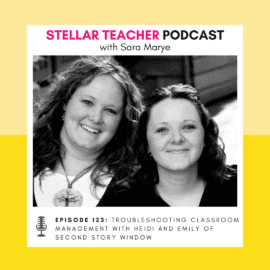
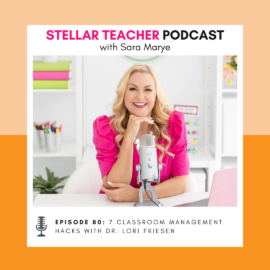
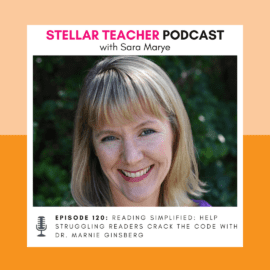
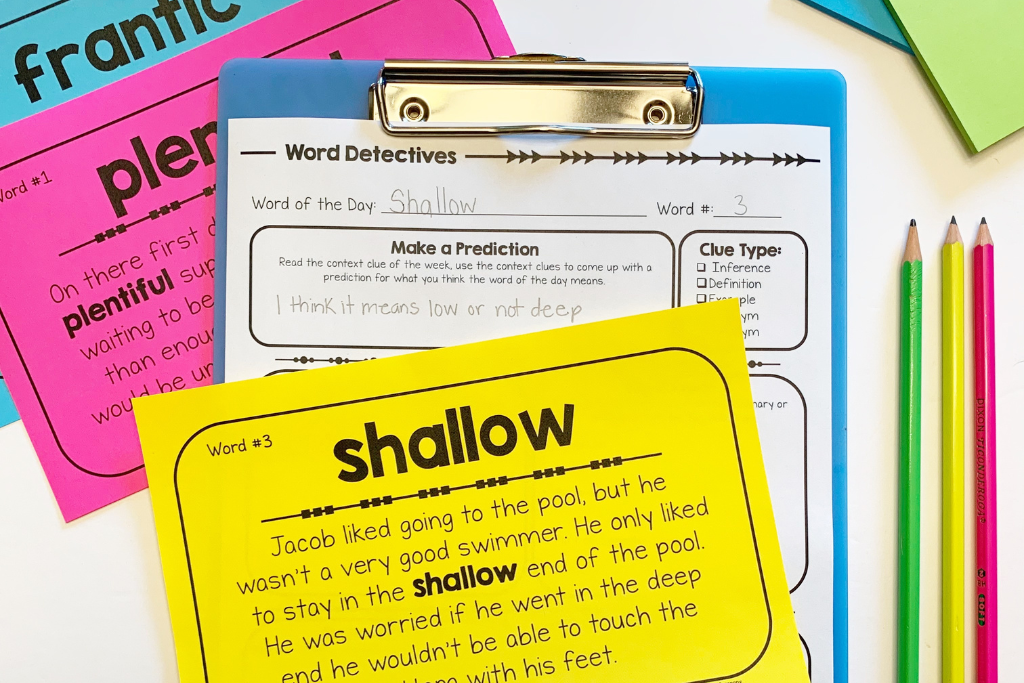

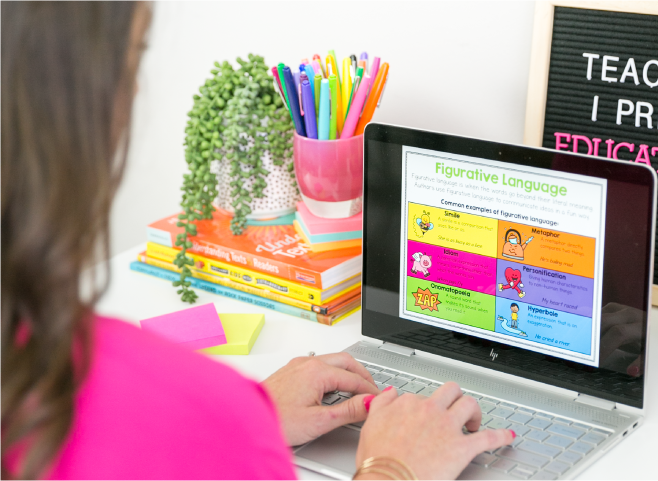
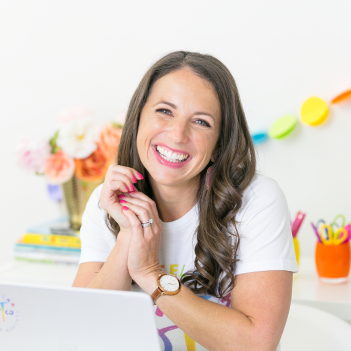
Leave a Comment
You must be logged in to post a comment.